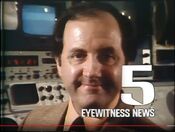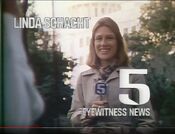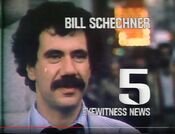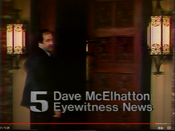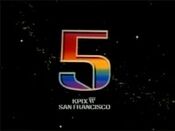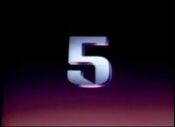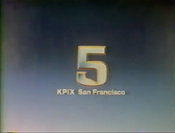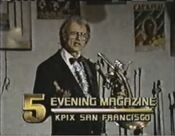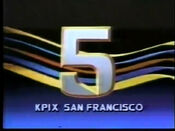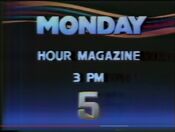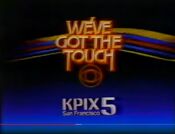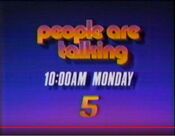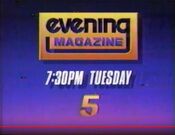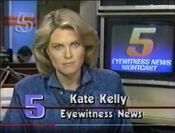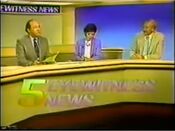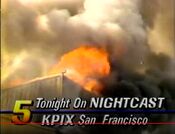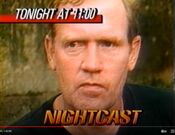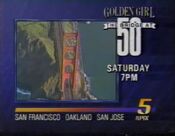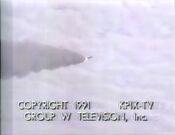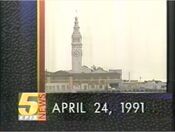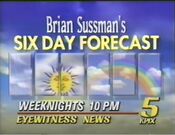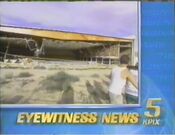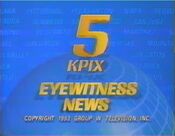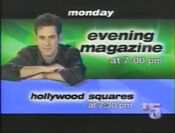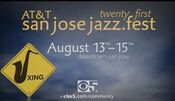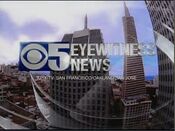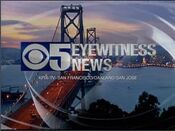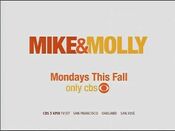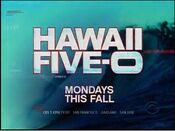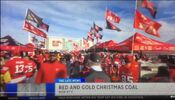KPIX-TV (Channel 5) is the CBS owned and operated television station in San Francisco, California. Through its parent company CBS Corporation, KPIX is co-owned with The CW affiliate KBCW-TV (Channel 44).
 | |
| San Francisco-Oakland-San Jose, California | |
|---|---|
| Branding | KPIX (general)
CBS News Bay Area (newscast) |
| Slogan | Stay Connected |
| Channels | Digital: 29 (UHF) |
| Subchannels | 5.1 - CBS |
| Affiliations | CBS |
| Owner | CBS Corporation
(CBS Broadcasting, Inc.) |
| Sister Station(s) | KPYX |
| First air date | December 22, 1948 |
| Call letters' meaning | PIX is a shorthand term for "pictures" |
| Former channel number(s) | Analog:
5 (VHF, 1948-2009) |
| Former affiliations | All secondary: |
| Transmitter power | 1000 kW |
| Height | 401 m |
| Facility ID | 25452 |
| Transmitter coordinates | 37°45′18.8″N122°27′10.4″W |
| Website | www.cbssf.com |
The station transmits from the Sutro Tower and its signal covers the San Francisco Bay Area. Known on the air as CBS 5 Bay Area, KPIX is home to one of the higher rated newscasts among CBS-owned stations. On January 28, 2008, KPIX started to broadcast local news in HD, becoming the third station in the Bay area to do so, after KGO-TV and KTVU. KPIX was also one of two Group W stations that became a CBS O&O, but had already been affiliated with CBS, the other being KDKA-TV in Pittsburgh.
In the few areas of the western United States where viewers cannot receive CBS programs over-the-air, KPIX is available to Dish Network customers as part of All American Direct's distant network package.
History[]
KPIX signed on December 22, 1948. It was the nation's 49th television station, as well as the first in northern California. It was owned by the Associated Broadcasters, owners of KSFO AM 560. Initially, KPIX transmitted from a tower on top of the Mark Hopkins Hotel on Nob Hill.[1]It later moved to a shared transmitter tower with KGO-TV on Mount Sutro and then to the Sutro Tower in 1973. KPIX's first studio was in the attic of the Mark Hopkins (just above the "Top of the Mark.")
KPIX immediately joined CBS due to a deal KSFO's owners had worked out with CBS a year earlier. KSFO was CBS radio's Bay Area affiliate from 1937 to 1941, when Associated Broadcasters backed out of a deal for CBS to buy the station. When KSFO was still affiliated with CBS, it was originally slated to move to 740 AM, the dial spot of KQW in San Jose. That frequency was the last 50,000-watt frequency available in the Bay Area, and KSFO was to raise its power to 50,000 watts after moving to 740. However, after KSFO parted ways with CBS, CBS moved its Bay Area affiliation to KQW and wasn't about to give up the obvious advantage of owning the last available 50,000-watt station in the Bay Area. After lengthyFederal Communications Commission (FCC) hearings, KSFO won the 740 frequency, but later decided to stay at 560 and concentrate its efforts on building a television station. It traded the 740 frequency to CBS in return for getting the CBS television affiliation for the Bay Area. KQW remained at 740 and CBS changed its call sign to KCBS.
The station also carried programming from the now-defunct DuMont Television Network until that network folded in 1956.[2] It even carried a few NBC programs until KRON-TV signed on in 1949, and programs from the short-lived Paramount Television Network,[2] among them Frosty Frolics,[3] Time For Beany,[4] Cowboy G-Men,[5] and Bandstand Revue.[6]
When KPIX's first competitor, KGO-TV, signed on in May 1949, KPIX produced programs to welcome it to the Bay Area. KPIX cameras were used on the first episode of the CBS Newsprogram See It Now on November 18, 1951, which opened with the first live simultaneous coast-to-coast TV transmission from both the East Coast (the Brooklyn Bridge and New York Harbor) and the West Coast (KPIX-produced images of the Golden Gate Bridge and San Francisco Bay), under the narration of Edward R. Murrow. Under its first general manager, Phil Lasky, KPIX gained an early reputation for news coverage, being noted for originating national CBS coverage of the Japanese Peace Conference of 1951 (the event which "officially" brought an end to World War II, similar to the function that the Treaty of Versailles served for World War I), held in San Francisco (for which Lasky was commended by then-CBS News president Sig Mickelson), as well as local news coverage of the 1953 crash of an Australian airliner while on approach to San Francisco International Airport, and a powder explosion a few weeks afterward at an explosives plant in suburban Hercules. In sports programming, KPIX originated the annual college football East-West Shrine Game for DuMont, and was the flagship station of the San Francisco Seals of the Pacific Coast League until 1954.[7]
In 1952 KPIX and KSFO moved into a new building at 2655 Van Ness Avenue, with KPIX staying there until about 1979, when it relocated to a 1920's era warehouse building on the corner of Battery and Broadway streets (refurbished by the architecture firm Gensler), where KPIX remains to this day. (KSFO moved to studios in the Fairmont Hotel, across the hall from the Tonga Room, later in the 1950s.) The building on Van Ness Avenue was the first building in San Francisco specifically built for television (it was demolished in 2006 to make way for a condominium complex[8]). Westinghouse Electric Corporation bought KPIX in 1954 and ran it as part of Group W, its broadcasting unit. During Westinghouse's ownership, KPIX was their only television station on the West Coast. In early 1996, Westinghouse merged with CBS, making KPIX a CBS O&O station and bringing it into common ownership with KCBS radio. Until this happened, KPIX had been CBS's longest-tenured affiliate; the distinction now goes to WUSA in Washington, DC.
In May 2006 KPIX moved its San Jose news bureau to the Fairmont Tower at 50 W. San Fernando Street. This was the original site of Charles Herrold's experimental broadcasts which were the precursor of KCBS. Although CBS was not aware of the significance of the San Fernando St. address when the move was planned, it quickly recognized and embraced its significance when informed, giving long-overdue credit to one of the inventors of radio broadcasting during the bureau's opening celebration.[citation needed]
Eyewitness Blues[]
Some personalities from KPIX, as well as KCBS radio, consists of mainly reporters and anchors from the two stations that would comprise the band named Eyewitness Blues. The band consists of Greg Brady (guitar), Keith Moon (Drums), Chris Detrick (Guitar), and Doug Sovern (bass). The band debuted in 2006.
Digital television[]
KPIX-TV shut down its analog signal on June 12, 2009 as part of the DTV transition,[9] it remained on channel 29 [10] PSIP is used to display KPIX-TV's virtual channel as 5 on digital television receivers.
Programming[]
Entertainment[]
KPIX was the station that came up with the concept for a local entertainment and lifestyles program, Evening Magazine. Evening Magazine began on KPIX-TV in August 1976, and within a year, the concept expanded to the other Group W stations. By Fall 1978, the Evening Magazine format was syndicated to non-Group W markets across the country as PM Magazine. The entire Evening/PM Magazine format was cancelled by the late 1980s. KPIX resurrected Evening Magazine in 1998. In 2005, Evening Magazine was retitled Eye On The Bay, to focus further on the San Francisco Bay Area. KBCW also aired Evening Magazine and Eye on the Bay in the early 2000s as reruns of the previous night's episode.
For most of the time before Westinghouse bought CBS, KPIX was CBS' largest affiliate. Despite this, until at least 1994 it was standard KPIX practice to pre-empt The Price Is Right, as well as other CBS morning daytime programs (for example, the first season of Tattletales was pre-empted for reruns of Perry Mason). Despite the pre-emptions, CBS was mostly satisfied with KPIX as it was among its highest rated affiliates in the country. In 1995, when CBS signed a long term deal with every Westinghouse station (just before the two companies merged), KPIX began broadcasting the entire CBS schedule in pattern with no preemptions, as per the affiliation agreement between Westinghouse and CBS.
For a time from 1992 to 1998, KPIX ran CBS primetime programming an hour earlier than typical for the Pacific Time Zone (i.e. from 7 p.m. to 10 p.m. instead of 8 p.m. to 11 p.m.), a practice which KOVR, its sister station in Sacramento, continues to this day.
Talk shows[]
KPIX was also known for the locally produced morning talk show, People are Talking, which began in 1978 with Ann Fraser and Ross MacGowan, and ran until 1991 (the other Group W stations also used the People are Talking format during these years). On KPIX, this show pre-empted The Price Is Right for a few years, and CBS had to schedule the popular game show on other Bay Area independent stations such as KOFY. At one point, a more celebrity-driven "People Are Talking in the Afternoon" aired with a small house band. Prior to the "People are Talking" franchise, Ann Fraser hosted "The Morning Show," essentially a 30 minute version of "People Are Talking." "The Morning Show" replaced "The Kathryn Crosby Show," hosted by Bing Crosby's wife, Kathryn. This was also a 30 minute show.
Sports[]
During the 1980s, KPIX broadcast the Oakland A's baseball team (at times pre-empting or delaying CBS network shows to do so) before the A's broadcasts moved to KRON. KPIX was at one time the home of the Golden State Warriors basketball team during the 1990s. KPIX-TV was also the exclusive home of the Bay to Breakers before it moved to KRON.
Captain Fortune[]
During the 1950s, KPIX produced a local children's program, Captain Fortune, on weekday afternoons and Saturday mornings. In addition to a number of live segments with an in-studio children's audience, the program featured the pioneering animated television episodes of Crusader Rabbit. The "captain" sometimes drew pictures to illustrate his stories. He was actually a talented artist named Peter Abenheim.[11] Abenheim authored a book, published in 1959 by Nourse Publishing of San Carlos, California, Captain Impossible at Sea.[12] Abenheim wrote the screenplay for a 1962 science fiction film, This Is Not a Test (also released as Atomic War Bride).[13] He was born in England on January 26, 1912. He came to San Francisco in 1932 and attended the California School of Fine Arts. He worked as an educational filmmaker. He died in San Francisco on May 2, 1988.[14]
Dick Stewart[]
From 1956 to 1959, Davenport, Iowa native Dick Stewart (born 1927) hosted a weekday variety program at KPIX. Due to the popularity of the film Gidget in 1959, the station decided to run a "Miss Gidget" contest on Dick Stewart's television program. The contest was won by Barbara Bouchet, who would become one of the "Regulars" on the Dance Party. She would later go on to be a famous star in her own right.
From 1959 to 1963, KPIX presented Dance Party, hosted by Stewart. The program invited local teenagers to come and dance to recorded music in the KPIX studios. Besides playing current recordings, Stewart sometimes welcomed popular recording stars to the program. Following the custom of American Bandstand, the singers would lip-synch to their recordings.
Stewart also hosted a number of "High School Salute" programs on Saturdays that spotlighted area high schools with interviews with students and faculty, as well as filmed segments from each school.[15]
Daytime Dramas[]
From its early days, KPIX carried the CBS soap operas, including The Guiding Light (1952–2009), As The World Turns (1956–2010), The Young and The Restless (1973–present), TheBold And The Beautiful (1987–present).
Other soaps shown on KPIX throughout the years include Search For Tomorrow (1951–82, when it moved to NBC), Love Of Life (1951–80), The Secret Storm (1954–74, though KPIX dropped it in September 1973), The Brighter Day (1954–62), The Edge of Night (1956–75, when it jumped to ABC), Love Is A Many Splendored Thing (1967–73), Where The Heart Is(1969–73), and Capitol (1982–87).
Court Dramas[]
In 1987-1988, KPIX ran a 90-minute block of court dramas from 4:30 to 6 p.m.: Superior Court, People's Court and The Judge. KPIX print ads stated, "It's a crime not to watch!"[16] Late in the 2000s decade, KPIX ran Judge Judy at 7:30 p.m.
Newscasts[]
KPIX uses the Eyewitness News format adopted by sister station KYW-TV in Philadelphia. KGO-TV also uses a similar type format, but KPIX had the Eyewitness News name first; KGO adopted its version from WABC-TV in New York City. For most of the last 30 years, KPIX has been runner-up to KGO.
As mentioned above, KPIX was a pioneer in local television news coverage in the Bay Area. Like most television stations, it presented a 15-minute evening news program until 1963, when the networks began expanding their evening newscasts to 30 minutes. One of KPIX's innovating program directors, Ray Hubbard, created "The Noon News." The anchors were John Weston, "Channel 5's Guy on the Go," and Wanda Ramey, "Channel 5's Gal on the Go." Ramey was one of the first women news anchors in the country. In 1966, KPIX hired the first African-American TV news reporters in the San Francisco market: Ben Williams, who had been the first Black reporter for the San Francisco Examiner a few years earlier, and Belva Davis, the first female African-American reporter on the West Coast.[17][18]
The station also launched a 10:00 p.m. hour-long newscast in the 1990s when they experimented with moving the prime time programming block back one hour. Then-NBC affiliate KRONalso experimented with a 7:00-10:00 prime-time block and news at 10:00P, but their newscast was only 30 minutes and they quickly reverted back to the standard 8:00-11:00 primetime block after only a year. KPIX did not revert to 8:00-11:00 prime time programming until 1998 after making no dent in KTVU's 10:00 pm news ratings, which has dominated the time slot for years in the Bay Area.
KPIX was also home to 30 Minutes Bay Area, a 30 minute news magazine created by 60 Minutes creator Don Hewitt after he retired from the national show. The "30 Minutes" concept was originally planned to air on many CBS O&O stations, but KPIX was the only station to implement the concept. 30 Minutes Bay Area was discontinued in early 2007, however, it continues to air as a special as of 2010.
KPIX also was one of the first local TV stations in the United States to provide full time environment reporting in its newscasts. CBS5's "The Greenbeat" (2007–2010), featuring reporter Jeffrey Schaub, offered viewers reports on sustainability,green technology and earth awareness issues.
Wendy Tokuda, who co-anchored "Eyewitness News" with Dave McElhatton from 1978 to 1992, recently returned to KPIX; as of 2007, Wendy anchors CBS 5 Eyewitness News at 5 with Allen Martin. In 1992, Wendy left KPIX to anchor evening newscasts on KNBC-TV in Los Angeles. In 1997, she returned to the Bay Area, and for the past decade, Wendy appeared on KRON 4 as evening anchor and reporter for her "Students Rising Above" student scholarship program that she founded in 1998. Wendy continues to work on her "Students Rising Above" program and airs her stories on KPIX newscasts.
In 2007 KPIX began broadcasting "Eye on the Bay" in High Definition. On January 28, 2008, KPIX began broadcasting its newscasts in 1080i high definition (behind KTVU and KGO), becoming the third station in the Bay Area to broadcast news and weather in HD, but most of the field cameras were still in 4:3 aspect ratio at that time of the switch. In mid-September 2010, KPIX started using HD cameras for its field reports, however, not all video footage(s) are shot in HD. KPIX utilizes a "Hi-Def Doppler" radar system during weather segments, which is positioned on Mount Vaca.
On March 3, 2008, KPIX launched a nightly 10 p.m. newscast on KBCW. It is broadcast in high definition. [1]
In mid-September 2010, KPIX introduced new graphics for its newscasts, which currently mirrors that of many of its sister-stations including WCBS and KCBS. KPIX currently uses "The Enforcer" music package, the basic theme of which has been used on many of CBS's O&O stations since the mid-1970s, when it was introduced by WBBM-TV. The station previously used several variants of the "Battery" theme for its newscasts for over a decade before the current change. In addition, the KPIX and KCBS radio websites merged along with the new website entitled "CBS San Francisco," which is similar to the revamp of most CBS O&Os. As of January 2011, KPIX airs a weekday morning newscast at 4:30 a.m.
News/station presentation[]

KPIX-TV's KPIX 5 News At 11 Video Open From Tuesday Night, February 28, 2014
Newscast titles[]
- The Noon News (1950s)
- Shell News (1950s)
- William Winter & The News (1950s)
- Channel 5 Eyewitness News (1965–1994 & 1995–2003)
- KPIX 5 News (1994–1995 & 2013-2022)
- CBS 5 Eyewitness News (2003–2013)
- CBS News Bay Area (2022-present)
Station slogans[]
- We Light Up the Bay (1977–1982)
- Looking Good Together, Channel 5 (1980–1981; localized version of CBS ad campaign)
- Reach For The Stars on Channel 5 (1981-1982; localized version of CBS ad campaign)
- Great Moments on Channel 5 (1982-1983; localized version of CBS ad campaign)
- We've Got The Touch, You and Channel 5 (1983-1984; localized version of CBS ad campaign)
- You and Channel 5, We've Got The Touch (1984-1985; localized version of CBS ad campaign)
- We've Got The Touch on Channel 5 (1985-1986; localized version of CBS ad campaign)
- Share The Spirit on Channel 5 (1986-1987; localized version of CBS ad campaign)
- Channel 5 Spirit, Oh Yes! (1987-1988; localized version of CBS ad campaign)
- Television You Can Feel on Channel 5 (1988-1989; localized version of CBS ad campaign)
- Get Ready For Channel 5 (1989-1991; localized version of CBS ad campaign)
- The Look of San Francisco is Channel 5 (1991-1992; localized version of CBS ad campaign)
- This is CBS on Channel 5 (1992-1994; localized version of CBS ad campaign)
- Channel 5, It's All Right Here (1993-1994; localized version of CBS ad campaign)
- The Best Place for News in The Best Place on Earth (1994–1998; news slogan)
- Everywhere in the Best Place on Earth (1998–2001)
- Everywhere (2001–2005)
- Always Worth Your Time (2005–2009)
- Stay Connected (2009–present)
News team[]
Current on-air staff[]
Anchors
- Ken Bastida - weeknights at 5 and 11 p.m.
- Elizabeth Cook - weeknights at 5 pm and 11 p.m.
- Veronica De La Cruz - weeknights at 6 and Nightbeat @ 10 p.m. (on KBCW)
- Michelle Griego - weekday mornings "CBS 5 Early Edition" and noon
- Anne Makovec - weekend mornings; general assignment reporter
- Kenny Choi - weekday mornings and noon
- Allen Martin - weeknights at 6 p.m.
- Phil Matier - Sunday Morning anchor; political reporter
- Amanda Starrantino - morning and noon anchor
- Juliette Goodrich - weekend evening anchor; general assignment reporter
KPIX 5 Pinpoint Weather Team
- Roberta Gonzales - weekday mornings and noon
- Paul Deanno - chief meteorologist; weeknights at 5, 6 and 11 p.m.
- Brian Hackney - meteorologist; weekend evenings
- Julie Watts - weekend morning meteorologist; Consumer Watch reporter
Sports team
- Dennis O'Donnell - sports director; weeknights at 6 and 11 p.m.
- Vern Glenn - sports anchor; weekend evenings; also sports reporter
- Andrea Nakano - sports anchor/reporte
Reporters
- Christin Ayers - general assignment reporter
- Andria Borba - general assignment reporter
- Melissa Caen - general assignment reporter
- Sharon Chin - general assignment reporter
- Kiet Do - general assignment reporter
- Jaclyn Dunn - weekday morning traffic reporter
- Devin Fehely - general assignment reporter
- Jessica Flores - general assignmrnt reporter
- Don Ford - general assignment reporter
- Juliette Goodrich - general assignment reporter; weekend evening anchor
- Sherry Hu - "Students Rising Above" reporter
- Anne Makovec - general assignment reporter; weekend morning anchor, "KPIX 5 Weekend"
- Phil Matier - political commentator; anchor Sunday mornings, "KPIX 5 Weekend"
- Maria Medina - general assignment reporter; fill-in anchor
- Len Ramirez - general assignment reporter
- John Ramos - general assignment reporter
- Emily Turner - general assignment reporter
- Joe Vazquez - general assignment reporter
- Jackie Ward - general assigment reporter
- Julie Watts - Consumer Watch reporter; weekend morning meteorologist
- Betty Yu - general assignment reporter
Local program hosts
- Brian Hackney - Eye on the Bay Co-host and producer; also weather fill-in anchor
- Liam Mayclem - Eye on the Bay Co-host and producer; also appears Thursday mornings on "CBS 5 Early Edition" with 'Liam's List" - a weekend guide to entertainment around the Bay Area.
- Thuy Vu - Eye on the Bay Co-host and producer.
- Dave Stoelk - Eye on the Bay correspondent
Notable past on-air staff[]
- Peter Abenheim - host of Captain Fortune, 1950s; artist and educational filmmaker (1912-1988)
- Eric Alvarez - freelance reporter (2004-2006)
- Wallis Alviar - reporter (2004-2007, now at KCAL in Los Angeles)
- Van Amburg - weekday news anchor (1962-1969, deceased)
- Jim Avila - weekend anchor/San Jose Bureau chief (1976-1980, now at ABC News)
- Ed Arnow - reporter (1970-1983)
- Jennifer Auther - reporter (1991-1992)
- Amalia Barreda - reporter (1974-1976, now at WCVB-TV in Boston)
- Joel Bartlett - chief meteorologist (1976-1989)
- Liza Batallones - traffic reporter (1995-2005, now reports traffic for 95.7 The Wolf in San Francisco and returned to KPIX as a fill-in in 2007)
- Stan Bohrman - anchor (1974-1975; deceased 1994)
- Renel Brooks-Moon - entertainment reporter (2003-2006)
- Lisa Chan - general assignment reporter/ weekend morning hosts (2001-2010)
- Anna Chavez - anchor (1992-1997)
- Christopher Chow - first Chinese-American reporter in the market (1970-1973)
- Sean Comey - South Bay correspondent (1997-2003)
- Christine Craft - anchor/reporter (1975-1977, now a radio host at KGO in San Francisco)
- David Cruz - anchor/reporter (1979-1985; now at KENS in San Antonio)
- April Cummings - morning news anchor (1999-2003; now at KRON-TV)
- Belva Davis - anchor/reporter (1966-1977; now at KQED-TV)
- Sandra Dickson - reporter (early 1970s)
- Tim Didion - reporter (1988-1994)
- Anna Duckworth - morning and noon reporter (2002-2010)
- Ysabel Duron - reporter (early 1970s, now at KRON-TV)
- Hal Eisner - reporter (late 1980s; now at KTTV/KCOP in Los Angeles)
- Eric Elliott - weekday/weekend morning meteorologist (2004-2008; now at WNEG-TV in Athens, Georgia)
- Jean Enersen - anchor (1962-1967, retired from KING 5 in Seattle)
- Lance Evans - reporter (1995-2003)
- Joe Fonzi - sports reporter/anchor (1982-1994, now at KTVU)
- Dan Fouts - sports anchor (1994-1997, now at NFL Network)
- Steve Fox - Evening Magazine co-host
- Bambi Francisco - technology reporter (1999-2003)
- Tom Franklin - anchor (1950s)
- Ann Fraser - People Are Talking host/reporter (1976-1997)
- Wayne Freedman - reporter (1989-1991, now at KGO-TV)
- Roland Galvan - weather anchor (1989-1990, deceased)
- Liz Gonzales - weekend anchor (1987-1995, deceased)
- Cynthia Gouw - reporter
- Emil Guillermo - reporter (1977-1980)
- Harold Greene - Anchor (1977, retired)
- Bob Haulman - weather anchor (1990-1991)
- Mike Hegedus - reporter (1980-1991, now at CNBC)
- Robert Handa - reporter (1990-1998, now at KTVU)
- Jack Hanson - "Jack's Place" host-children's show (early 1960s, now with Comcast)
- Joe Hoskinson - traffic reporter (2005-2006)
- Heather Hudgens - traffic reporter (2006-2008)
- Dr. Leon Hunsaker - weatherman (1974-1975)
- Tracy Humphrey - morning and noon meteorologist (2007-2011)
- Cheryl Hurd - reporter (1992-1998, now at KNTV)
- Sherry Hu - East Bay bureau (1983-2011)
- Jan Hutchins - sports anchor
- David Jackson - reporter
- John Kessler - Anchor "Early Edition" and noon (2002-2010)
- Sue Kwon - host of "Consumer Watch Extra"; also business and technology reporter (2002-2010)
- Jonathan Karsh - Evening Magazine host/contributor (1998-2001, now a filmmaker [2])also on CBS's Kid Nation)
- Bill Lagattuta - reporter (1980-1982
- Mike Lee - reporter (1968-1975)
- John Lobertini - reporter (1999-2008)
- Ron Magers - anchor/reporter (1968-1974, retired)
- Janelle Marie - traffic reporter (1992-1994) now on KGO
- Bill Martin - meteorologist (1993-1995, now at KTVU)
- Dave McElhatton - longtime anchor (1976-2001) (deceased August 23, 2010)
- Ross McGowan - People Are Talking host/reporter (1978-1992, now retired from KTVU)
- Brendan McLaughlin - anchor/reporter (now at WFTS-TV in Tampa)
- Lee Mendelson - producer; better known for work on Peanuts TV specials
- Samantha Mohr - chief meteorologist (2001-2007, now at The Weather Channel)
- Doug Murphy - anchor/reporter (1982-2005, deceased)
- Christopher Nance - weather anchor (1983-1985)
- Dan Navarro - reporter (1974-1976)
- Malou Nubla - Evening Magazine co-host (2000-2006, now runs a communications company [3])
- Joe Oliver - anchor/reporter (1996-1998, now at WESH-TV in Orlando)
- Andy Park - anchor (1974-1975; deceased 2009)
- Jeanette Pavini - "Consumer Watch" reporter (2001-2008)
- Hank Plante - anchor/reporter & political editor (1986-2010)
- Roz Plater - reporter (2001-2005)
- Rollin Post - reporter/commentator (1961-1973)
- Rick Quan - weekend sports anchor (1986-2007)
- Wanda Ramey - noon co-anchor/reporter; first female anchor in western U.S. (1957-1967; deceased, August 15, 2009 at age 85)
- Manuel Ramos - reporter (1980-2008)
- Trish Regan - reporter (2002-2003)
- Troy Roberts - reporter (1985-1987, now at CBS News)
- Barbara Rodgers - noon weekdays, Bay Sunday, Bay Area Jefferson Awards, retired (1979-2008)
- Mike Rowe - Evening Magazine co-host (2001-2005; now host of Discovery Channel's Dirty Jobs' and annoucer of ABC World News with Diane Sawyer)
- Tony Russomanno - reporter (1991-2008)
- Jeffrey Schaub - North Bay Bureau chief (1990-2010)
- Bill Schechner - reporter (1976-1981, 1992-2008)
- Dr. Nancy Snyderman - medical reporter (1988-2004)
- Drew Soicher - sports anchor (1997-1999, now at KUSA-TV in Denver)
- Jim Steck - anchor (circa 1973)
- Dick Stewart - host of Dance Party and High School Salute
- Sandra Stricker - reporter (1985-1993)
- Mark Sugerman - reporter (1981-2005)
- Brian Sussman - meteorologist (1989-2000)
- Kaity Tong - reporter (1976-1979, now at WPIX-TV in New York)
- Noelle Walker - reporter (2006-2008)
- Jo Pearson - anchor (1979-1982)
- Wayne Walker - sports anchor (1974-1994, deceased)
- Anna Werner - investigative reporter (2004-2010, now at CBS News)
- John Weston - anchor/reporter
- Ben Williams - reporter/anchor (1966-1991)
- Colleen Williams - anchor/reporter (1981-1983, now at KNBC in Los Angeles)
- Nola Woods - reporter (1999-2006)
- Jan Yanehiro - Evening Magazine co-host (1976-1989)
- Janet Yee - reporter (2001-2007)
KPIX branding[]
KPIX and its sister station, Baltimore's WJZ-TV (an ABC affiliate during its pre-merger Group W history) would become the only two CBS-owned television stations to continue using this logo font. KPIX was the only CBS-owned station on the West Coast to not follow the CBS Mandate for years after the merger, referencing itself as KPIX-TV Channel 5.KPIX's distinctive "5" logo dates from the days as a Westinghouse station, when the "Group W font" was standard on KPIX and its sister stations after about 1965. When Westinghouse merged with CBS, most of the former Group W stations eventually retired the font.
Finally in 2005, KPIX fell in line with the mandate and called itself CBS 5, later CBS 5 Bay Area (although some references to "CBS 5" were heard in commercials as early as 2003). But it was briefly branded simply as KPIX 5 between 1993 and 1996, even dropping the Eyewitness News name and called itself KPIX 5 News at the same time before reverting.
Gallery[]
References[]
- ^ http://cbs5.com/info/kpix.history.cbs5.2.452923.html
- ^ a b King, G.H.; King, Vance (eds.) (1952). Production Encyclopedia. Hollywood, CA: Hollywood Reporter. pp. 716–717.
- ^ "TV Programs". Oakland Tribune (Oakland, CA): pp. 9. 1953-10-10.
- ^ "14-City May ARB Ratings of Syndicated Shows". Billboard. 1953-07-25.
- ^ "Syndicated Pix ARB Multi-City Ratings". Billboard: 16. 1954-04-10.
- ^ "The Nation's Top Television Programs". Billboard: 10. 1955-07-30.
- ^ a b Murray, Michael D.; Godfrey, Donald G. (eds.) (1997). Television in America: Local Station History from Across the Nation. Ames, IA: Iowa State Press. pp. 361–363. ISBN 0813829690.
- ^ http://www.bayarearadio.org/schneider/ksfo-kpix.shtml
- ^ http://hraunfoss.fcc.gov/edocs_public/attachmatch/DA-06-1082A2.pdf
- ^ CDBS Print
- ^ http://www.tvparty.com/lostSF-captfortune.html
- ^ https://www.alibris.com/search/books/author/Abenheim,%20Peter
- ^ imdb.com
- ^ http://www.askart.com/askart/a/peter_abenheim/peter_abenheim.aspx
- ^ KPIX Dance Party - Home Page
- ^ TV Guide (San Francisco Metropolitan Edition), Sept. 12, 1987
- ^ http://www.emmysf.tv/index.php?option=com_content&view=article&id=258:williams&catid=3&Itemid=53
- ^ Jones, Carolyn (May 9, 2010). "People vs. The Chron". The San Francisco Chronicle.
External links[]
- KPIX-TV on the English Wikipedia
- CBSSanFrancisco.com - Official KPIX-TV Website
- CWBayArea.com - Official KBCW-TV Website
- Query the FCC's TV station database for KPIX-TV
- BIAfn's Media Web Database -- Information on KPIX-TV










